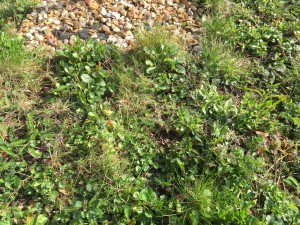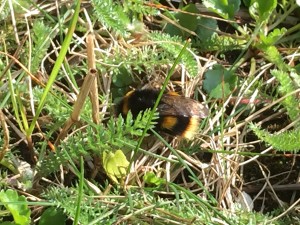Spot the queen bumblebee resting in my wildflower meadow
Lovely sunny weather today, had a very large B. terrestris queen earlier in the day feeding and resting. Later in the afternoon, found this one resting in my new wildflower lawn, part of my wildlife garden.
Based upon a little research and my own observations, I have a rough theory that priorities change when queen bumblebees emerge from hibernation. After emerging it goes like this:
1) nectar searching , (restore fat) feed, rest;
2) nectar/pollen searching (restore fat, mature ovaries) feed, rest;
3) nectar/pollen searching, feed, rest, short nest site recce;
4) nectar/pollen searching, feed, rest, longer nest site recce;
5) nectar searching, feed, rest, nest site seeking;
6) nectar searching, feed, diligent nest site seeking;
7) nectar searching, feed, nest site preparation;
8) nectar feeding, (knows where nectar is), nest site set up.
Looking at other queens lately I feel we are at stage 5) around here. During the early stages, beside nectar used as her flight fuel, she feeds heavily on pollen (protein) to develop her ovaries. Resting here includes sunning themselves weather permitting. They will use the dead leaves forming deep litter on the ground to hide under during the night.
Later on I had what looked very similar to a Bombus vestalis, a large cuckoo bumblebee with darkened wings, freshly emerge with her bright sulphur yellow side patches at the bottom of her white tailed abdomen and deep black colourations on her thorax. Her ‘collar’ was a bright deep orangey colour. Being a cuckoo bee she had no pollen baskets, which I showed to my neighbour with her on my hand, to his amazement!!
See numerous specimens here at rest: Bumblebee queens, where do they rest
For more information about Bumblebees: Bumblebee Conservation Trust
Interested in Citizen Science and pollinators? : The Buzz Club
Refs:
Bumblebees by D V Alford.



Recent Comments